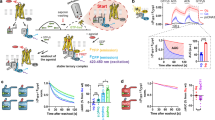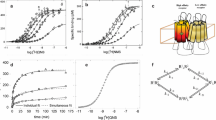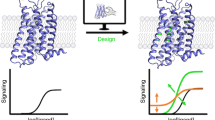Abstract
We present a new concept of partial agonism at G protein–coupled receptors. We demonstrate the coexistence of two functionally distinct populations of the muscarinic M2 receptor stabilized by one dynamic ligand, which binds in two opposite orientations. The ratio of orientations determines the cellular response. Our concept allows predicting and virtually titrating ligand efficacy, which opens unprecedented opportunities for the design of drugs with graded activation of the biological system.
This is a preview of subscription content, access via your institution
Access options
Subscribe to this journal
Receive 12 print issues and online access
$259.00 per year
only $21.58 per issue
Buy this article
- Purchase on Springer Link
- Instant access to full article PDF
Prices may be subject to local taxes which are calculated during checkout


Similar content being viewed by others
References
Pierce, K.L., Premont, R.T. & Lefkowitz, R.J. Nat. Rev. Mol. Cell Biol. 3, 639–650 (2002).
Venkatakrishnan, A.J. et al. Nature 494, 185–194 (2013).
Kenakin, T. Nat. Rev. Drug Discov. 1, 103–110 (2002).
Kenakin, T. & Christopoulos, A. Nat. Rev. Drug Discov. 12, 205–216 (2013).
Rosenbaum, D.M., Rasmussen, S.G.F. & Kobilka, B.K. Nature 459, 356–363 (2009).
Warne, T. et al. Nature 469, 241–244 (2011).
Swaminath, G. et al. J. Biol. Chem. 280, 22165–22171 (2005).
Yao, X. et al. Nat. Chem. Biol. 2, 417–422 (2006).
Kofuku, Y. et al. Nat. Commun. 3, 1045 (2012).
Nikolaev, V.O., Hoffmann, C., Bünemann, M., Lohse, M.J. & Vilardaga, J.-P. J. Biol. Chem. 281, 24506–24511 (2006).
Zürn, A. et al. Mol. Pharmacol. 75, 534–541 (2009).
Kenakin, T. & Miller, L.J. Pharmacol. Rev. 62, 265–304 (2010).
Nygaard, R. et al. Cell 152, 532–542 (2013).
Black, J.W. & Leff, P. Proc. R. Soc. Lond. B Biol. Sci. 220, 141–162 (1983).
Bruning, J.B. et al. Nat. Chem. Biol. 6, 837–843 (2010).
Overington, J.P., Al-Lazikani, B. & Hopkins, A.L. Nat. Rev. Drug Discov. 5, 993–996 (2006).
Antony, J. et al. FASEB J. 23, 442–450 (2009).
Bock, A. et al. Nat. Commun. 3, 1044 (2012).
Prilla, S., Schrobang, J., Ellis, J., Höltje, H.-D. & Mohr, K. Mol. Pharmacol. 70, 181–193 (2006).
Schröder, R. et al. Nat. Biotechnol. 28, 943–949 (2010).
Schröder, R. et al. Nat. Protoc. 6, 1748–1760 (2011).
Kloeckner, J., Schmitz, J. & Holzgrabe, U. Tetrahedr. Lett. 51, 3470–3472 (2010).
Dallanoce, C. et al. Bioorg. Med. Chem. 7, 1539–1547 (1999).
Disingrini, T. et al. J. Med. Chem. 49, 366–372 (2006).
Schrage, R. et al. Br. J. Pharmacol. 169, 357–370 (2013).
Hoffmann, C. et al. Nat. Methods 2, 171–176 (2005).
Jäger, D. et al. J. Biol. Chem. 282, 34968–34976 (2007).
Ehlert, F.J. Mol. Pharmacol. 33, 187–194 (1988).
May, L.T., Leach, K., Sexton, P.M. & Christopoulos, A. Annu. Rev. Pharmacol. Toxicol. 47, 1–51 (2007).
Ehlert, F.J., Griffin, M.T., Sawyer, G.W. & Bailon, R. J. Pharmacol. Exp. Ther. 289, 981–992 (1999).
Griffin, M.T., Figueroa, K.W., Liller, S. & Ehlert, F.J. J. Pharmacol. Exp. Ther. 321, 1193–1207 (2007).
Acknowledgements
We thank M. Kepe for excellent technical assistance and Corning Inc. for their support on the Epic system. A.B. is a member of the graduate school Theoretical and Experimental Medicine at the University of Bonn. This work was funded by the Deutsche Forschungsgemeinschaft (DFG) by grants to K.M. (MO 821/2-1), U.H. (HO 1368/12-1), E.K. (KO 1583/3-1) and C.H. (SFB487 TPA1). B.C. is funded by the North-Rhine-Westphalia International Graduate Research School BIOTECH-PHARMA at the University of Bonn.
Author information
Authors and Affiliations
Contributions
A.B. conceived the project, developed the mathematical framework for dynamic ligands, conducted all of the binding experiments in live CHO-M2 and CHO-M2W422A cells and all of the [35S]GTPγS binding experiments and DMR assays and supervised experiments related to binding to membranes of CHO-hM2 cells and to characterization of the allosteric fragments. B.C. characterized the allosteric fragments in binding and functional assays and conducted binding assays of the X-6-phth series in membranes of CHO-hM2 cells. F.K. conducted binding assay of the X-6-naph series in membranes of CHO-hM2 cells. R.M. synthesized and characterized 8-naph. J.B. conducted FRET experiments. M.M. synthesized and characterized isox-8-naph. C.D. provided isox and isox-6-phth. D.K. conducted all of the [35S]GTPγS binding experiments to membranes of CHO-M2W422A cells. C.H. planned and supervised FRET experiments. U.H. planned and supervised chemical syntheses. C.T., M.D.A., C.H. and U.H. contributed to discussions. E.K. provided essential ideas. A.B. and K.M. made figures and wrote the manuscript. K.M. supervised the overall research.
Corresponding author
Ethics declarations
Competing interests
The authors declare no competing financial interests.
Supplementary information
Supplementary Text and Figures
Supplementary Results, Supplementary Figures 1–11 and Supplementary Tables 1–3. (PDF 1187 kb)
Supplementary Note 1
The binding model for dynamic ligands (PDF 428 kb)
Supplementary Note 2
Chemical syntheses and characterization (PDF 137 kb)
Rights and permissions
About this article
Cite this article
Bock, A., Chirinda, B., Krebs, F. et al. Dynamic ligand binding dictates partial agonism at a G protein–coupled receptor. Nat Chem Biol 10, 18–20 (2014). https://doi.org/10.1038/nchembio.1384
Received:
Accepted:
Published:
Issue Date:
DOI: https://doi.org/10.1038/nchembio.1384
This article is cited by
-
GPCR drug discovery: integrating solution NMR data with crystal and cryo-EM structures
Nature Reviews Drug Discovery (2019)
-
Characterization of methanthelinium binding and function at human M1–M5 muscarinic acetylcholine receptors
Naunyn-Schmiedeberg's Archives of Pharmacology (2018)
-
Competitive association binding kinetic assays: a new tool to detect two different binding orientations of a ligand to its target protein under distinct conditions?
Naunyn-Schmiedeberg's Archives of Pharmacology (2017)



